Classic Basil Pesto
Nothing beats the flavor of a good pesto. The herby fresh flavor along with the richness and saltiness of the cheese makes it irresistible!
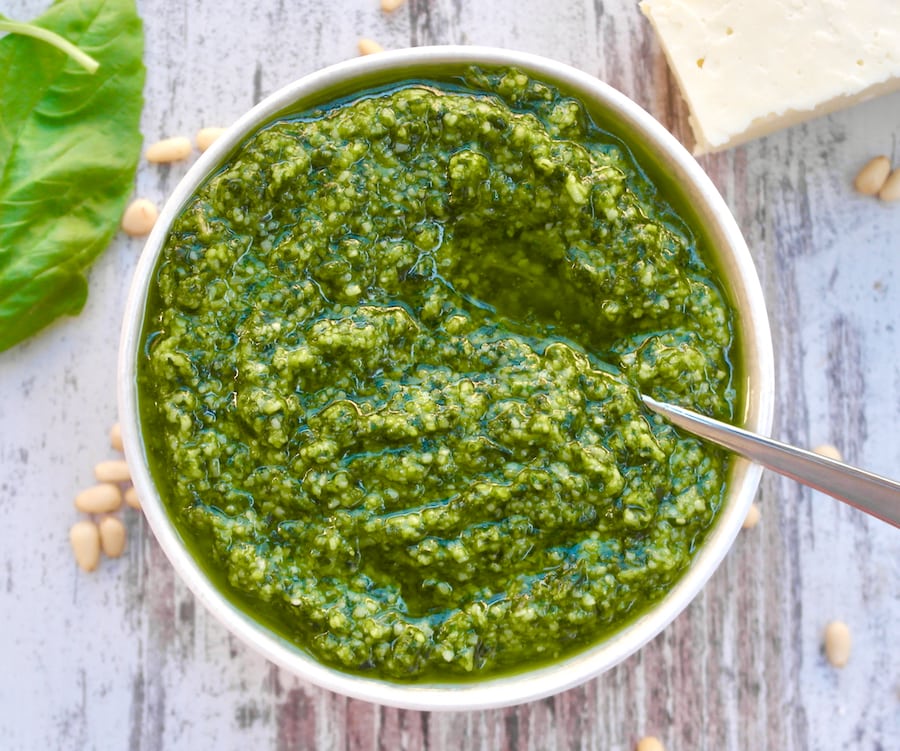
Basil pesto is such a wonderful combination of flavors: aromatic basil along with salty cheese and garlic all come together with a good dose of olive oil. And homemade pesto tastes so much better than the store bought kind!
This recipe is based on the traditional Genoese recipe (pesto alla Genovese), the only difference is that it is not made using a mortar and a pestle. The classic pesto recipe is made with basil, olive oil, pine nuts, parmesan and pecorino cheese. You may see substitutions in other recipes out there but then it would not be a true pesto alla genovese.
Is Pesto Good For You?
Pesto is made mainly from antioxidant rich foods, this includes extra virgin olive oil, basil, pine nuts and garlic. In addition you get all the good fats from olive oil and the pine nuts. The cheese is a source of protein, but also some extra fat and salt. It is important to note though since it is so flavorful, a little goes a long way. You only need a couple of tablespoons to flavor a bowl of pasta. It is also great as a dip with vegetables. And when you compare it to typical mayo rich dips or creamy white sauces pesto is definitely healthier.
Classic Basil Pesto Ingredients
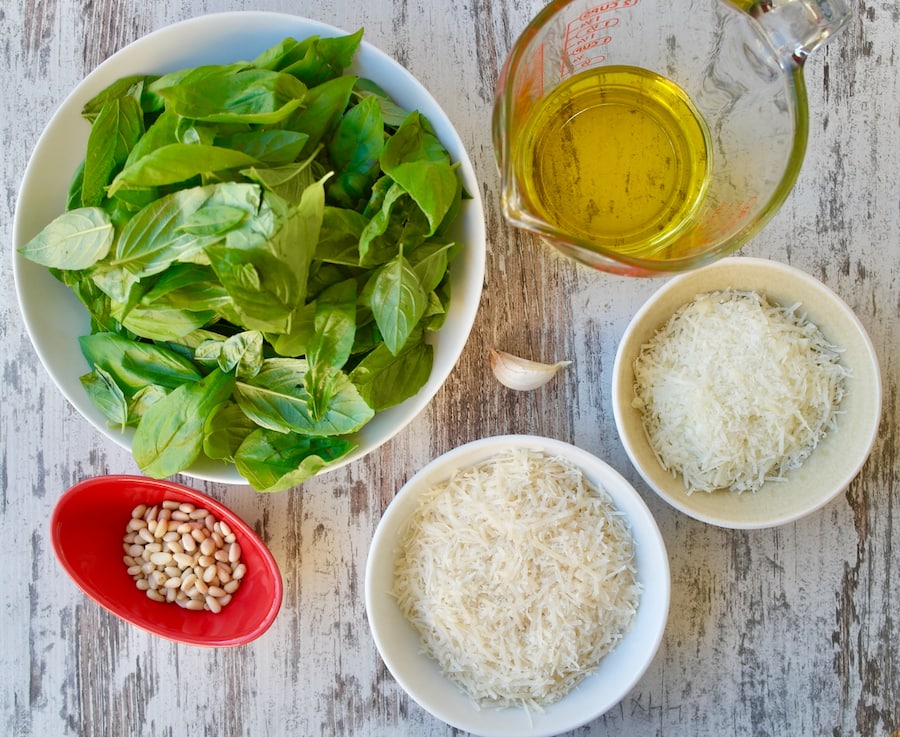
- Basil: You want to use sweet or Genovese basil. Do not use the smaller basil, (it is very common in Greece) as it will be too “spicy” and overwhelm the sauce.
- Olive oil: Use the best and the freshest extra virgin olive oil you can find. An old (and/or rancid) or flavorless olive oil will ruin the sauce.
- Pine nuts: Although some recipes suggest that you can use other nuts (you can) pine nuts really provide a characteristic nutty/buttery flavor we are looking for in the authentic recipe.
- Cheese: The authentic Genovese pesto contains 2 cheeses parmesan and pecorino romano or sardo
- Garlic: You may remove the germ from the center of the garlic clove to make it less pungent.
Secrets to Making the Best Pesto with a Food Processor
Yes, this is made in a food processor, you don’t just throw all the ingredients in there all at once and mix. Rather you want to make sure everything is blended but not over blended as that will affect flavor (overheating can make it bitter), affect the color (bruising the basil leaves darkens them) and the texture (pesto should be somewhat grainy not super smooth).
To avoid overheating you can also place the food processor bowl and blades in the refrigerator for an hour before.
How to Make Classic Basil Pesto
Weigh your basil leaves and the cheese. Providing weight rather than cups is the most precise way to measure the amount of the ingredients. For the basil make sure you remove the stem, only use the leaves. Wash the basil leaves and dry them very well by placing them on paper towels. For the cheese I recommend weighing as well because the grating of the cheese can affect the volume.
Crush the garlic and place it in the food processor along with a pinch coarse salt, half of the basil and 1 tbsp of olive oil. Blend at a low speed and pulse rather than continuously mixing at high speed. This avoids overheating which can make the pesto bitter.
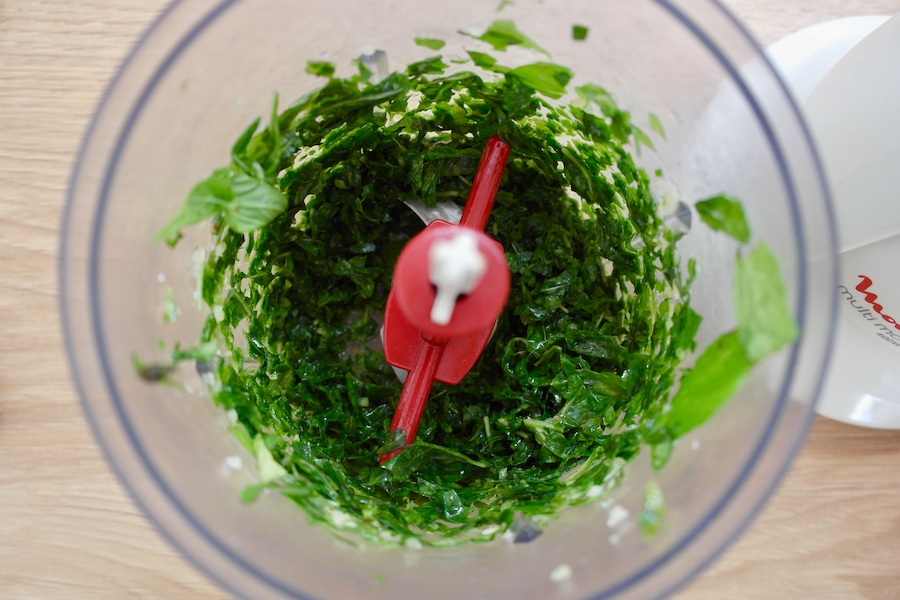
Crush the garlic and place it in the food processor along with a pinch coarse salt, half of the basil and 1 tbsp of olive oil. Blend at a low speed and pulse rather than continuously mixing at high speed. This avoids overheating which can make the pesto bitter.
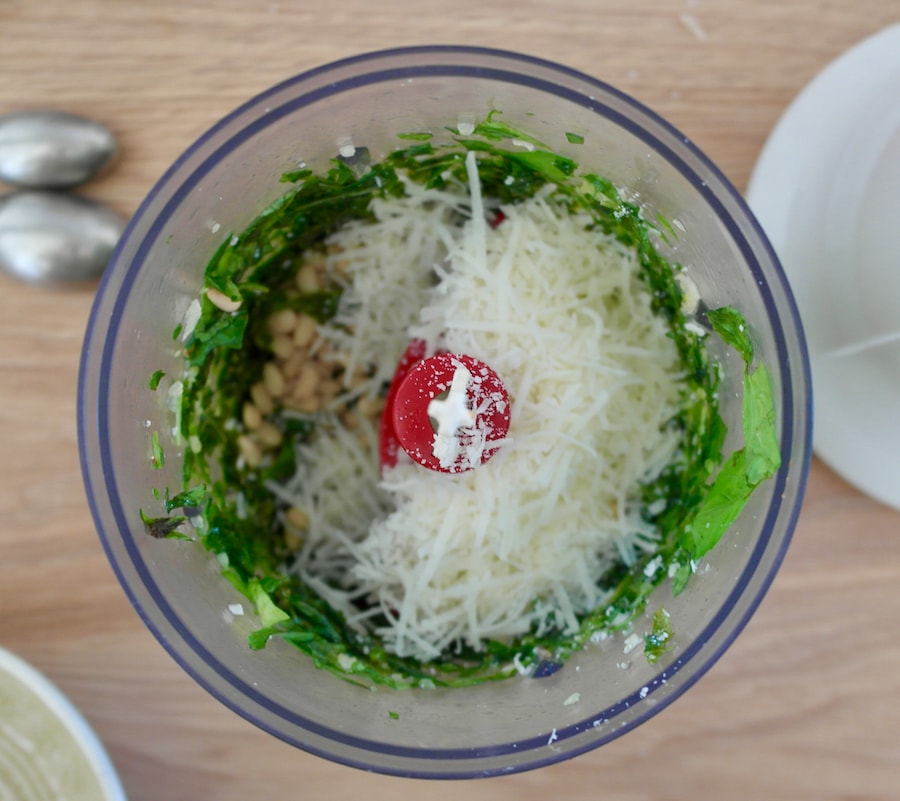
Add the rest of basil and continue pulsing for a few seconds. Then add the pine nuts, Parmesan, pecorino and 3 tbsp olive oil.
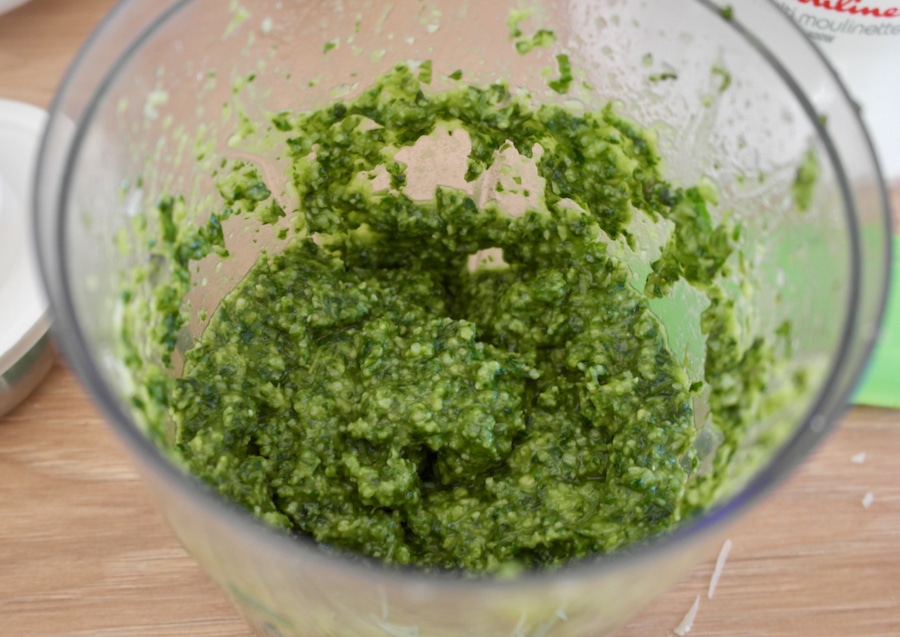
Mix again intermittently, until everything is well blended and somewhat smooth with a bit of graininess.
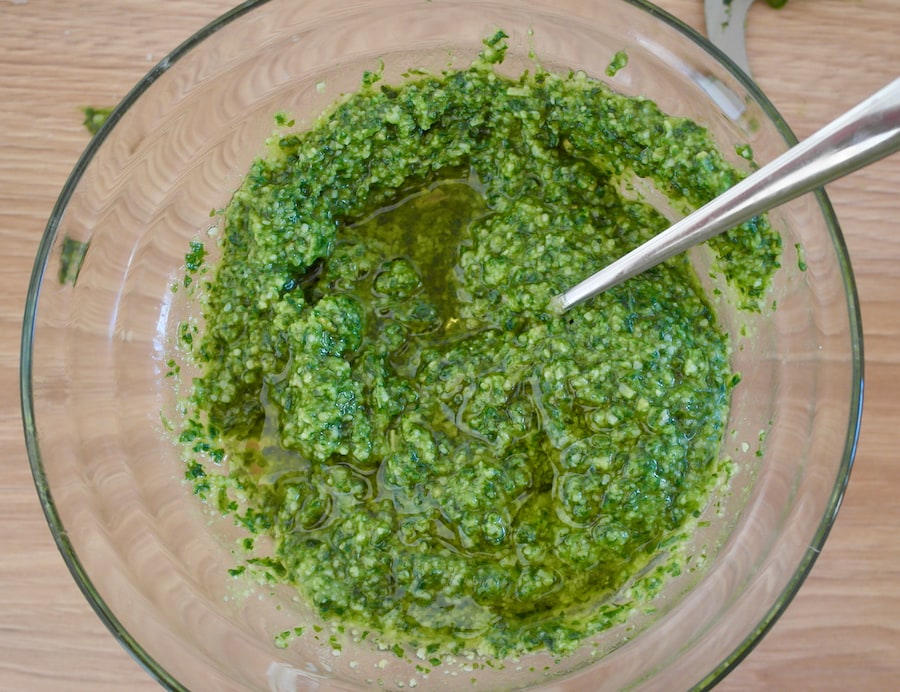
Empty the pesto into a bowl and dilute it by adding 1 tablespoon olive oil , little by little until you have a soft texture.
Storing and Freezing Pesto
Place the pesto on an airtight jar covering the sauce with a layer of olive oil and refrigerate for up to 3 days.
You can freeze pesto by placing single portions (about ¼ cup) on a sheet of plastic wrap. Wrap and then wrap again with another sheet of plastic wrap. Store in the freezer for up to 3 months. Thaw at room temperature.
What To Eat with Pesto
Pesto truly goes with everything, here are my favorite ways:
- With pasta (of course!). Just mix the pesto with your favorite pasta and a bit of fresh ground pepper.
- As a dip. Serve with carrot sticks, celery, cucumber, cherry tomatoes and breadsticks.
- As a spread in a sandwich.
- On pizza
- As a sauce with chicken
- As a topping for potatoes
- In a tomato salad
Want More Mediterranean Diet Recipes and a 14 Day Meal Plan? My Cookbook is here! Get your copy! >>
You may also like these healthy dips and sauces
- Black Olive Tapenade
- Beet and Walnut Hummus
- Authentic Tzatziki – Greek Garlic Yogurt Dip
- Greek Eggplant Dip – Melitzanosalata
Classic Basil Pesto Sauce
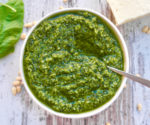
Ingredients
- 50 grams (1 ¾ ounces) basil leaves (no stems) Approximately 2 ½ cups (lightly packed)
- 2 cloves garlic
- 1 pinch coarse sea salt
- 6 tbsp (90 ml) Extra virgin olive oil
- 2.5 oz (70 g) or ⅔ of a cup grated parmesan cheese
- .5 oz (15 g) or 3 tbsp grated pecorino cheese
- 2 tbsp (15 g) pine nuts
Instructions
- Wash the basil leaves and dry them very well by placing them on paper towels.
- Crush the garlic and place it in the food processor along with a pinch coarse salt, half of the basil and 1 tbsp of olive oil. Blend at a low speed and pulse rather than continuously mixing at high speed.
- Add the rest of basil and continue pulsing for a few seconds.
- Then add the pine nuts, Parmesan, pecorino and 3 tbsp olive oil. Mix again intermittently, until everything is well blended and somewhat smooth with a bit of graininess.
- Empty the pesto into a bowl and dilute it by adding 1 tbsp olive oil, little by little until you have a soft texture.
Notes
- To avoid overheating you can also place the food processor bowl and blades in the refrigerator for an hour before.
- Weigh your basil leaves. Providing weight rather than cups is the most precise way to measure the amount of basil you need. Make sure you remove the stem, only use the leaves.
- Place the pesto on an airtight jar covering the sauce with a layer of olive oil and refrigerate for up to 3 days.
- You can freeze pesto by placing single portions (about ¼ cup) on a sheet of plastic wrap. Wrap and then wrap again with another sheet of plastic wrap. Store in the freezer for up to 3 months. Thaw at room temperature.
SAVE FOR LATER AND PIN IT!
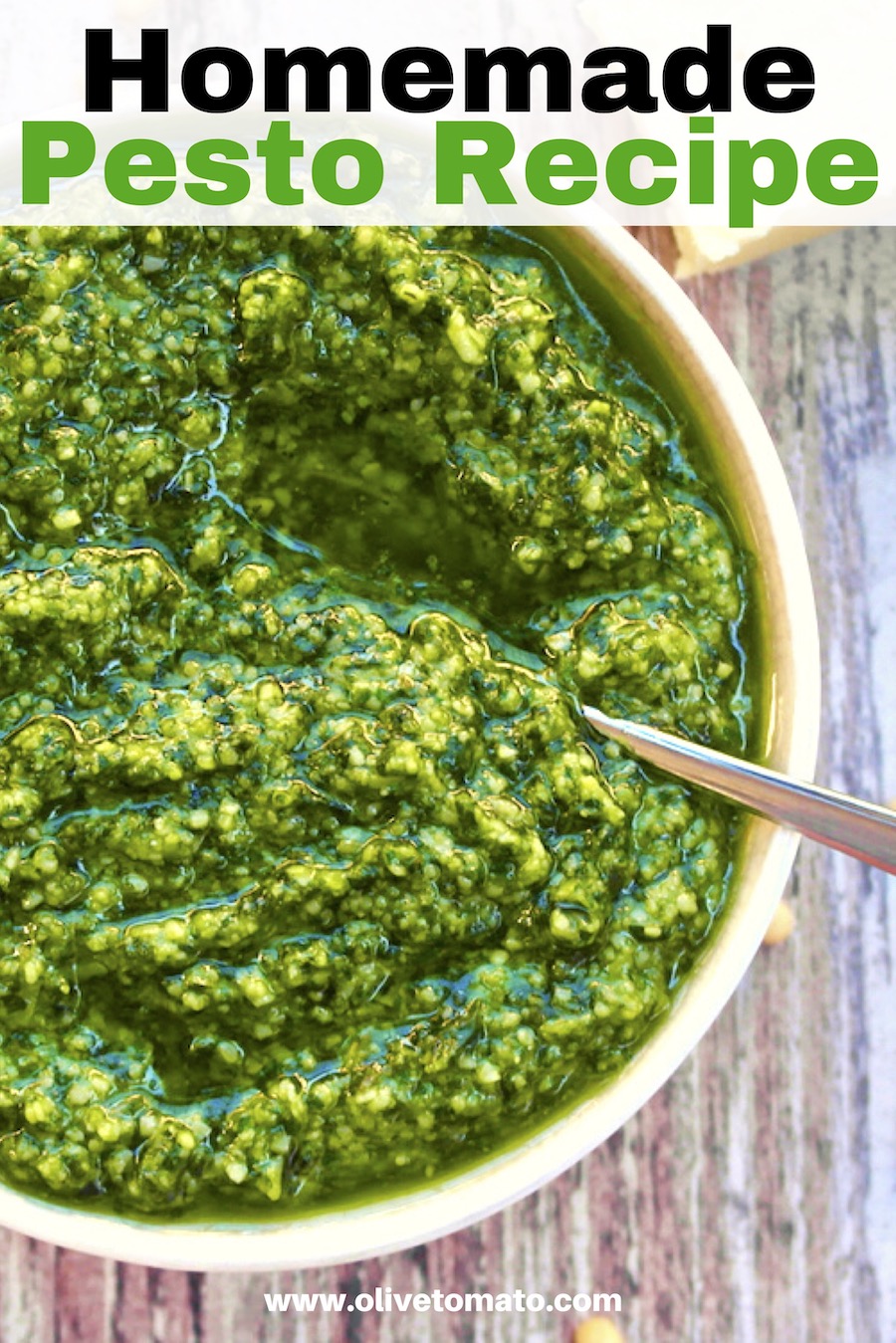

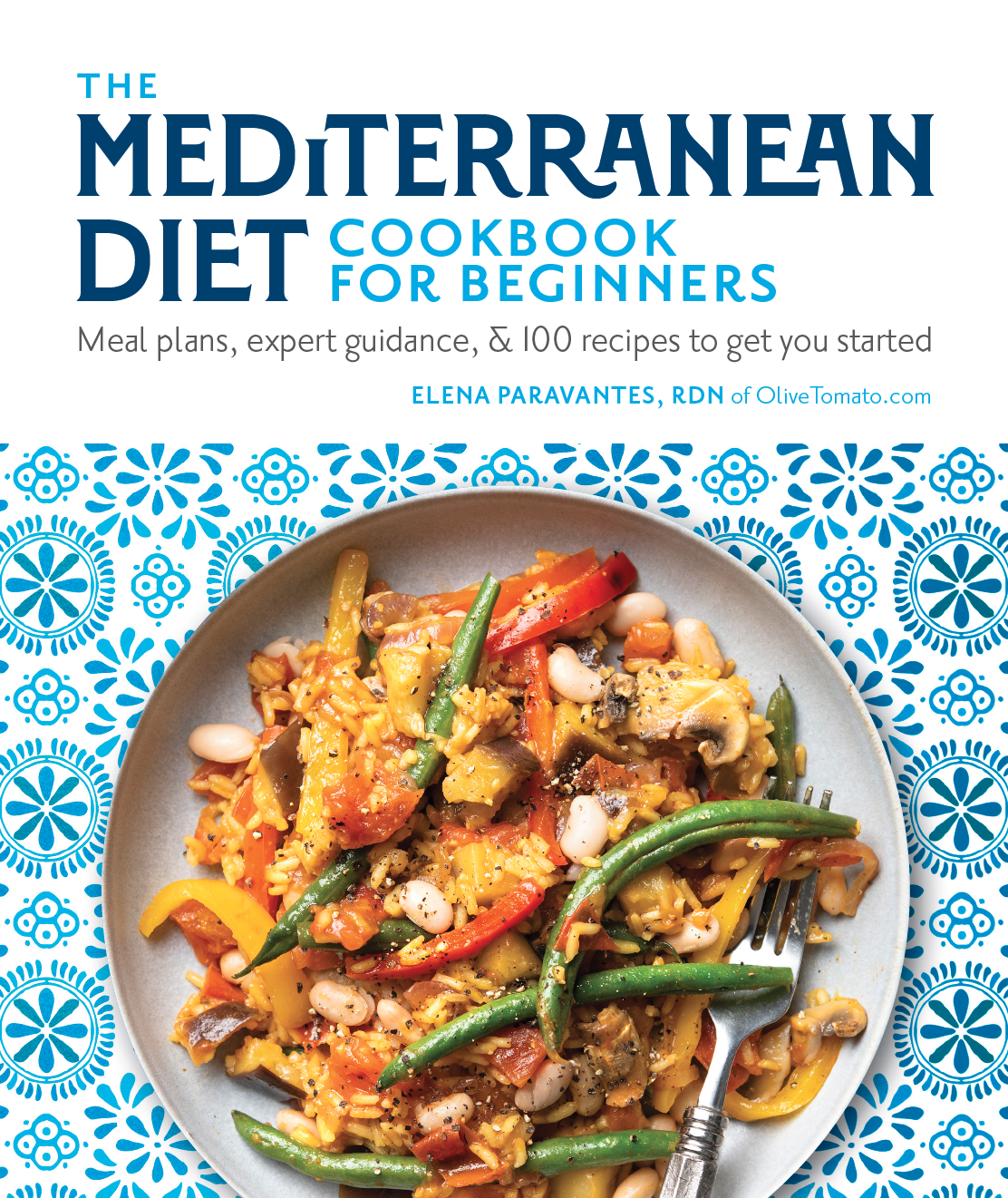
Great recipe! We used handpicked pinyon pine nuts and fresh basil. We loved the pecorino cheese.
Thankyou, right now my basil plant is not growing – can lemon balm be used instead as that is growing well. or any suggestions for lemon balm. love your posts.
Hi Sujata, Thanks, happy you enjoy the posts! Lemon balm has a different flavor profile, it could be made in a dip/sauce but probably with different ingredients.